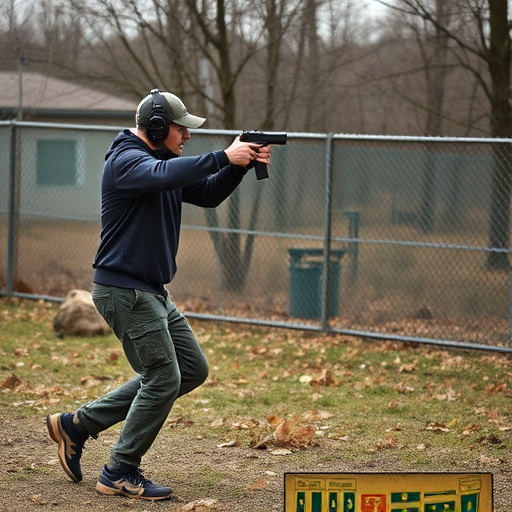Bear spray and personal pepper spray serve distinct purposes. Bear spray uses high capsaicin levels to deter bears, while personal pepper spray has lower concentrations for human defense. Bear spray is effective at longer ranges in open spaces, while personal pepper spray is easier to carry and use in close quarters. Users should consider their environment, potential threats, and comfort level when choosing between them. Proper training, understanding usage, and safety precautions are essential for both types of self-defense tools.
“Discover the power of self-defense with Oleoresin Capsicum (OC) spray, a versatile tool for outdoor enthusiasts facing bear encounters or urban individuals seeking personal protection. This article demystifies the difference between bear spray and personal pepper spray, breaking down their active ingredients and effects. We’ll guide you through choosing the right defense mechanism based on your needs, offer insights on usage, training, and safety precautions, ensuring informed decisions in potentially dangerous situations.”
- Understanding Bear Spray and Personal Pepper Spray
- Active Ingredients and Their Effects
- Choosing the Right Defense Tool for You
- Usage, Training, and Safety Precautions
Understanding Bear Spray and Personal Pepper Spray
Bear spray and personal pepper spray are both defensive tools designed for self-protection, but they serve distinct purposes and have key differences, particularly in terms of their target and effectiveness. Bear spray, as the name suggests, is specifically formulated to deter bears. It’s a powerful repellent that creates a barrier between the user and the bear, temporarily disabling the animal enough to allow for escape or further action. The primary active ingredient, capsaicin, is derived from chili peppers and irritates the bear’s eyes, nose, and respiratory system.
Personal pepper spray, on the other hand, is designed for use against humans as a self-defense mechanism. It’s less potent than bear spray but still packs a punch to incapacitate an attacker temporarily. While both contain capsaicin, personal pepper spray typically has a lower concentration, making it safe for use around people without causing severe harm or long-lasting effects. This makes it a popular choice for individuals seeking a portable and effective way to deter potential threats in urban environments.
Active Ingredients and Their Effects
The primary active ingredient in oleoresin capsicum spray, often referred to as pepper spray, is capsaicin, a natural compound derived from chili peppers. When used in self-defense tools, capsaicin irritates the eyes and respiratory system of an attacker, causing temporary blindness and difficulty breathing. This effect allows the user to escape or gain time for further action.
Comparing oleoresin capsicum spray to bear spray, a stronger variant designed for wildlife encounters, reveals distinct differences. Bear spray typically contains higher concentrations of capsaicin and other chemicals tailored to deter aggressive animals. While pepper spray is effective against human assailants, its effects may not be as powerful or long-lasting as bear spray against larger, more determined threats. This distinction highlights the importance of understanding the active ingredients and their specific applications in self-defense tools, whether for wildlife encounters or personal protection.
Choosing the Right Defense Tool for You
Choosing the right defense tool is crucial, especially when considering options like bear spray versus personal pepper spray. Each has distinct applications and advantages in various scenarios. Bear spray, for instance, is designed to deter aggressive bears encountered in wilderness settings, using a powerful stream of capsicum oleoresin to create a temporary blind spot and escape route. On the other hand, personal pepper spray is tailored for self-defense against humans, causing temporary disorientation and pain to potential assailants.
When deciding between these two, consider your primary need: bear encounters or human aggression prevention. Bear spray offers longer range and can be more effective in open spaces, while personal pepper spray is easier to carry and use in close quarters. Always assess the environment, potential threats, and your comfort level with each tool before making a choice.
Usage, Training, and Safety Precautions
When it comes to self-defense tools like oleoresin capsicum (OC) spray, understanding usage and training is key. Unlike bear spray, designed for animal deterrence, personal pepper spray is directly aimed at neutralizing an assailant by temporarily blinding them and causing severe discomfort. Training involves familiarization with the device’s mechanism, target zones, and safe distance. It’s crucial to practice spraying techniques in a controlled environment to ensure accuracy and reduce misfires.
Safety precautions are paramount when carrying OC spray. Users should be aware of local laws regarding its possession and use. The spray can cause severe irritation to eyes, skin, and respiratory systems, so proper ventilation is essential during deployment. Additionally, users must keep the spray out of reach of children and animals, store it in a secure location, and regularly inspect the device for any signs of damage or malfunction. Comparing OC spray to bear spray reveals distinct differences; while bear spray has a wider range and longer duration, personal pepper spray offers more control and precision, making it ideal for close-quarters defense.
When choosing between bear spray and personal pepper spray, understanding their distinct active ingredients and effective ranges is key. While both offer valuable self-defense, bear spray is designed for wildlife encounters, with a wide reach but longer activation time, whereas personal pepper spray focuses on close-range protection against humans, providing immediate yet shorter-lasting effects. Ultimately, selecting the right defense tool depends on your specific needs and environment, ensuring you’re prepared for potential threats. Remember, proper usage, training, and safety precautions are vital to making the most of either option.
